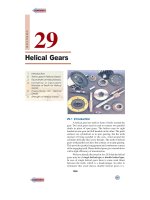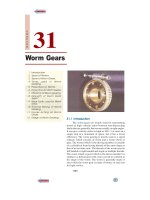hand book of mechanical
Bạn đang xem bản rút gọn của tài liệu. Xem và tải ngay bản đầy đủ của tài liệu tại đây (16.75 MB, 296 trang )
HANDBOOK
of
MECHANICAL DESIGN
'7S~
/
HANDBOOK
of
MECHANICAL DESIGN
BY
GEORGE
NORDENHOLT
F.
Editor of Product Engineering
JOSEPH KERR
Managing Editor
of Product Engineering
AND
JOHN SASSO
Associate Editor of Product Engineering
First Edition
Third Impression
McGRAW-HILL BOOK COMPANY,
NEW YORK AND LONDON
1942
Inc.
HANDBOOK OP MECHANICAL DESIGN
CksPYRIGHT, 1942, BY THE
McGraw-Hill Book Company,
Inc.
PRINTED IN THE UNITED STATES OF AMERICA
All rights reserved. This book, or
parts thereof,
may not
be reproduced
in any form without permission of
the publishers.
THE MAPLE PRESS COMPANY, YORK,
PA.
PREFACE
Many engineering departments, perhaps most, compile and keep up to date a
manual which may be called the standards book, reference book, engineering department standards, or which may be given some other name. Also, many design
In such books will be found a vast fund
engineers build their own book or manual.
of engineering data and many methods of design procedure not found in existing
handbooks.
When
Product Engineering was launched as a pubhcation to serve the design
was obvious to the editors that a great service could be rendered to the
profession by gathering and publishing data, information, and design procedures such
Thus, the first number of
as are contained in engineering department manuals.
Product Engineering in January, 1930, contained a reference-book sheet for design
Soon
calculations, a feature which has been continued in practically every number.
afterward, there was added to Product Engineering's editorial content another regular
engineers,
it
feature, a two-page spread illustrating standard constructions, possible variations
by
which to achieve a desired result, and similar design standards covering constructions,
drives, and controls.
It was soon found impossible to meet all the requests for additional copies of
reference-book sheets and design standards. The demand continued to increase and
numerous readers suggested that the material be compiled into book form and pubIt was in answer to this demand that the authors compiled this book.
lished.
Other than the major portion of the chapter on materials and a few other pages
that have been added to round out the treatment of certain subjects, all the material
in this book appeared in past numbers of Product Engineering, although some of it has
been condensed or re-edited. Very little of the material in this book can be found in
the conventional handbooks, for this Handbook of Mechanical Design contains practically no explanations of theoretical design.
It confines itself to practical design
methods and procedures that have been in use in engineering design departments.
The authors wiU welcome suggestions from users of this book and especially
desire to be notified of any errors.
We wish to make special acknowledgment of the material on typical designs
appearing in Chapters IV and VI, by Fred Firnhaber, now of Landis Tool Company;
the nomograms by Carl P. Nachod, vice-president of the Nachod & U. S. Signal Co.;
the standard procedure in the design of springs
by W. M.
Griffith of Atlas Imperial
Company; the spring charts by F. Franz; the methods for calculating
and other nomograms by Emory N. Kemler, now associate professor of
mechanical engineering at Purdue University; the nomograms for engineering calculations by M. G. Van Voorhis, now on the editorial staff of Product Engineering; and
to S. A. Kilpatrick and 0. J. Schaefer for their brilliant series of articles, which have
Diesel Engine
belt drives
PREFACE
vi
slightlj^ condensed form, on the design of formed thin-sheet aluminumAcknowledgment is also made here of data on properties of materials
contributed by the Alimiinum Company of America, United States Steel Corporation,
and the American Foundrymen's Association.
Other engineers whose contributions to Product Engineering have been incorporated in this book are H. M. Brayton, 0. E. Brown, E. Cowan, C. Donaldson, R. G. N.
Evans, C. H. Leis, A. D. McKenzie, G. A. Schwartz, A. M. Wasbauer, B. B. Ramey,
been included in
alloy sections.
Harper, H. M. Richardson, G. A. Ruehmling, T. H. Nelson, E. Touceda,
Rigby, R. S. Elberty, Jr., and G. Smiley.
J.
W.
George
F.
Nordenholt,
Joseph Kerr,
John Sasso.
New
York,
April, 1942.
W.
S.
CONTENTS
Pa.qe
Preface
v
CHAPTER
I
Charts and Tables for General Arithmetical Calculations
1
Arc length versus Central Angle. Chordal Height and Length of Chord. Length of Material for Bends.
Volumes in Tanks, Horizontal Round. Volumes in Tanks, Vertical Round. Volume,
Circular Segments.
Weight, and Cost. Weights of Cylindrical Pieces. Chart of Unit and Total Weights. Chart of Weights
and Volumes. Moment of Inertia of Prisms; Flywheels; Gears and Armatures. Radii of Gyration.
Transferring Moments of Inertia to Parallel Axis.
WR^ of Symmetrical bodies. Centrifugal Force.
Mean Cooling Temperature. Solution of
Forces in Toggle Joint. Linear Motion. Rotary Motion.
Ohm's Equations. Total Resistance of Parallel Circuits.
CHAPTER
II
Materials
33
Cast Irons. Alloy Cast Irons. Effect of Nickel and Chromium on Cast Iron.
Malleable Iron Castings. Cast Carbon Steels. High Alloy Cast Steels. Low Alloy Cast Steels. CorroIron-nickel-chromium Alloys. AlumiProperties of Stainless Steel.
sion and Heat-resistant Cast Steels.
num Base Alloys. Magnesium Base Alloys. Insulating Materials. Plastic Materials. Phenolic
Selection of Materials.
Laminated Molded Materials.
Steels for
Automotive Parts.
CHAPTER
III
Beams and Structures
71
Thin Aluminum Sheet
Sections.
Compression Members. Angles in Compression.
Shear Resisting Webs. Diagonal Tension Webs. Hollow
Box Sections Subjected to Torsion. Chart for Determining Bending Moments. Deflection of
Girders.
Variously Loaded Beams. Stresses in Cantilever Beams. Tensile Strength of Round Wires. Rectangular
Stress Calculations for
Shear Members.
Moments
Vertical
Stiffeners
for
of Inertia.
CHAPTER
IV
Latches, Locks and Fastenings
95
Locking Devices. Retaining and Locking Detents. Wire Locks and Snap Rings. Taper- Pin Applications.
Hinges and Pivots. Clamping Shoes and Plugs. Lock Bolts and Indexing Mechanisms. Machine
Clamps. Door and Cover Fastenings. Bolt Diameter, Load, and Stress.
CHAPTER V
Springs
121
Spring Wire Specifications. Design Stresses. Torsional Moduli. Allowable
Based on Endurance Limits. Natural Frequency. Formulas for Helical Springs. Permissible
Manufacturing Tolerances. Form for Design Calculations. Standard Drawings for Springs. Table of
Wire Gages and Diameters, with Their Squares, Cubes, and Fourth Powers. Inspection and Testing of
Designs of Helical Springs.
Stresses
Graphical Solution of Helical Spring Formulas. Helical Spring Charts for Specified Ratio of
Designs of Tension Spring Ends. Graphical Designs of Flat Cantilever Springs.
Graphical Designs of Semielliptic Laminated Springs.
Springs.
Loads and Lengths.
59376
,
CONTENTS
viil
Page
CHAPTER
VI
Power Transmission Elements and Mechanisms
Flexible Couplings.
151
Shaft Diameters for Torsion and Bending.
—
Shaft Diameters for Torsional Deflection.
Shaft Diameters for Lateral Deflection. Shaft Diameters A.S.M.E. Code. Two-bearing Shafts of
Uniform Strength. Stress in Rotating Disk. Velocity Chart for Gears and Pulleys. Flat-belt Length and
Flat-belt Speed-Horsepower Charts.
Belt Horsepower Charts. Flat-belt Horsepower
and V-belt Horsepower Charts. V-belt Lengths. Short-center Belt Drives. Chart for
Calculating Needle Bearings. Thrust Bearing Friction Moments. Bronze Bearing Alloys. Shaft Seals.
Gibs and Guides.
Roller-Bearing Seals. Sleeve-bearing Seals. Safety Gears. Shifting Mechanisms.
Cam Designs. Variable-speed Devices. Transport Mechanisms. Automatic Feed Hoppers. Glueapplying Mechanisms.
Pulley Diameter.
Charts.
Flat
CHAPTER
VII
Drwes and Controls
207
WR^. Analysis of Motor Load. Selection of Motor Type. Inquiry 'Form for Electric
Motors. Winding Connection Diagrams for Multispeed Motors. Electric Control Methods. Electrically
Operated Values. Automatic Timers. Trigger Switch Mountings. Thermostatic Mechanisms. Automatic Stops.
Significance of
CHAPTER
VIII
Design Data on Production Methods
Fusion
Welding.
Welding.
Die Casting.
Resistance
Permanent Mold Casting.
251
Flame Hardening. Centrifugal Casting.
Flame Cutting. Powdered Metal Pressings.
Furnace Brazing.
Forging.
HANDBOOK OF MECHANICAL DESIGN
CHAPTER
I
CHARTS AND TABLES
For General Arithmetical Calculations
The
charts and
nomograms
in this chapter include only those pertaining to
Nomograms,
general arithmetical calculations, as hsted below.
for use in the design of specific
machine elements or structures
and tables
be found in the
charts,
will
chapters devoted to the design of those elements or structures.
Moment
Len^jth
of Inertia, Radius of Gyration,
and
Page
Arc Length vs. Central Angle
Chordal Height and Length of Chord
Length of Material for Bends
WRPage
2
Prisms
16
3
Flywheels, Gears, and Armatures
17
4
Radii of Gyration
Transferring to Parallel Axis
17
WR-
19
Area
of
18
Symmetrical Bodies
Force
Circular Segments
8
Centrifugal
26
Forces in Toggle Joint
27
Volume
Tanks, Horizontal Round
Tanks, Vertical Round
Volume, Weight, and Cost
Force, Velocity,
9
10
11
and Acceleration
Linear Motion
28
Rotary Motion
29
Heat and Temperature
Mean
Weight
Cooling Temperature
,
CyUndrical Pieces
Unit and Total Weight
12
14
Solution of
Weight and Volume
15
Total Resistance of Parallel Circuits
30
Electrical
Ohm's Equations.
31
32
HANDBOOK OF MECHANICAL DESIGN
ARC LENGTH VERSUS CENTRAL ANGLE
(Angle of Bend, Length, and Radius)
Draw
a straight hne through the two
known
points.
The answer
will
at the intersection of this line with the third scale.
Example: For a
6-in. radius
and 45-deg. bend, length
of arc is 4.7 in.
be found
CHARTS AND TABLES
CHORDAL HEIGHT AND LENGTH OF CHORD
^vill be found
a straight line through the two known points. The answer
at the intersection of this line with the third scale.
height h of
Example: Length of chord is 3 in., and radius of circle is 4 in. The
Draw
the chord
is
0.29
in.
HANDBOOK OF MECHANICAL DESIGN
LENGTH OF MATERIAL FOR
90 -DEG.
BENDS
As shown in Fig. 1, when a sheet or flat bar is bent, the position of the neutral plane with respect to the outer and
For a sharp corner,
inner surfaces will depend on the ratio of the radius of bend to the thickness of the bar or sheet.
As the radius of the bend is
the neutral plane will lie one-third the distance from the inner to the outer surface.
This
increased, the neutral plane shifts until it reaches a position midway between the inner and outer surfaces.
factor should be taken into consideration when calculating the developed length of material required for formed pieces.
The table on the following pages gives the developed length of the material in the 90-deg. bend. The following
formulas were used to calculate the quantities given in the table, the radius of the bend being measured as the distance
from the center of curvature to the inner surface of the bend.
For a sharp corner and for any radius of bend up to T, the thickness
1
a 90-deg. bend will be
.
L =
2.
L
for
(«-D
For any radius of bend greater than 2T, the length
L =
3.
1.5708
of the sheet, the developed length
L
for a 90-deg.
bend
will
be
(r +
^^
1..5708
R=
For any radius of bend between IT and 2T, the
T= Stock thickness
Inside radius
value of L as given in the table was found by interpolation
The developed length L of the material in any bend
other than 90 deg. can be obtained from the following
H
^
-M h-
Neutral
1t-5*>2
irl
line
formulas:
1.
For a sharp corner or a radius up to T:
T
L =
2.
0.0175 (li
For a radius
L =
of
+ t) X
2T
degrees of bend
E
Sharp corner
R=Torless
or more:
5(S+|)
X
0.0175
R=iTto2T
Fig.
R= 2T or more
1.
degrees of bend
For double bends as shown
in Fig.
2, if fii
X = V2BiR, +Ri- B/2)
With Ri, Ri, and B known:
flo - B
fl,
""^ ^ =
—rT+rT
L = 0.0175(S, + R2)A
where A is in degrees and L is the developed
-|-
Ss
is
greater than B:
-t-
If
Ri
+
Y =B
Ri
is less
cosec
The value
of
than B, as in Fig.
A —
{Ri
X when B
+
is
fl2)(cosec
A —
cotan A)
greater than Ri
X =B
The
length.
3,
total developed length
L
cot
A
+
Ri
To
be
7S2)
(cosec
A -
cotan A)
+
0.0175(^1 4- R2)A
'
simplify the calculations, the table on this page gives the equations for X, Y, and the developed length for
common angles of bend. The table on following pages gives L for values of R and T for 90-deg. bends.
EQUATIONS FOR
Angle A,
deg.
+
required for the material in the straight section plus that in the two arcs will be
L = Y
various
will
-h {Ri
X, Y,
AND DEVELOPED LENGTHS
CHARTS AND TABLES
DEVELOPED LENGTH IN INCHES OF MATERIAL REQUIRED FOR
90-DEG.
BEND
6
HANDBOOK OF MECHANICAL DESIGN
DEVELOPED LENGTH IN INCHES OF MATERIAL REQUIRED FOR
90-DEG.
BEND
{Continued)
CHARTS AND TABLES
DEVELOPED LENGTH IN INCHES OF MATERIAL REQUIRED FOR
7
90-DEG.
BEND
(Continued)
HANDBOOK OF MECHANICAL DESIGN
8
AREAS OF CIRCULAR SEGMENTS
-50
-7000
-40
5,000
F-2
-
3,000
-
2,000
-30
-
1,000
-20
1^
500
1
0.9
rO.8
A=
-0.7
Note: The ang/e
0.01745 R^arc cos
is
-~
•300
- (R-H)Vh('2R-H)
-200
expressed in degrees
~—
100
10
0.5
0.5
-7
E-30
i-20
•0.4"
o
=-5
<.
10
c
-5
-0.3
=-3
'-2
-0.25
-2
-0.2
hO.5
-0.3
-0.2
-0.15
^0.1
:
h 0.05
0.03
0.1
•=-0.02
Dra'w a straight
line
through the two kno'wn points.
The answer
will
be found
at the intersection of this line with the third scale.
Example: For a
sq. in.
10-in. radius
and
H
=
4.0 in.,
H/R =
0.40
in.
Area
A =
46
CHARTS AND TABLES
VOLUMES
IN
HORIZONTAL ROUND TANKS WITH FLAT ENDS
F-30
/Turning
line
Notes: Shift decimal point on volume
scale two' points for a one-point
sliift
on
diameter scale; one point for a one-point
shift on length scale.
H
= 0.9 ft. H/D = 0.15. Join 0.15 on
Example: Tank is 6 ft. in diameter and 15 ft.' long.
scale with 6 on diameter scale.
From point of intersection with turning line, draw line to
15 ft. on the length scale.
The volume scale shows 300 gal. If D had been 0.6 ft.,
0.09 ft.,
and length the same, the answer would be 3.00 gal.
H/D
H
HANDBOOK OF MECHANICAL DESIGN
10
VOLUMES
10
IN VERTICAL
ROUND TANKS WITH FLAT BOTTOMS
r^'OOO
f-io
-9
^9
r4,000
-8
'-7
r- 3,000
-2,000
-6
r6
- 1,000
800
^5
-5
^600
r80
f-60
-2
40
•30
Draw a straight line through the two known
points.
-20
The answer
•^6
be found at the
In reading the answer on the volume scale,
decimal point on volume scale two places
for one-place shift on diameter scale, and
one place for one-place shift on height scale.
Example: Diameter of tank is 4 ft. Depth
of liquid is 2.5 ft.
Volume as read is 230 gal.
If diameter of tank is 0.4 ft. and depth 2.5 ft.,
shift
r-10
will
intersection of this line with the third scale.
volume
is
2.3 gal.
CHARTS AND TABLES
VOLUME, WEIGHT, AND COST CHART
11
12
HANDBOOK OF MECHANICAL DESIGN
CHARTS AND TABLES
WEIGHTS OF CYLINDRICAL
Diam-
PIECES,
POUNDS PER INCH OF LENGTH
13
(Continued)









